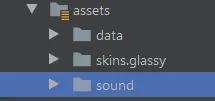我在我的Android项目的“assets”文件夹中有一些带有HTML文件的文件夹。我需要在列表中显示这些来自assets子文件夹的HTML文件。我已经编写了一些关于创建这个列表的代码。
lv1 = (ListView) findViewById(R.id.listView);
// Insert array in ListView
// In the next row I need to insert an array of strings of file names
// so please, tell me, how to get this array
lv1.setAdapter(new ArrayAdapter<String>(this, android.R.layout.simple_list_item_1, filel));
lv1.setTextFilterEnabled(true);
// onclick items in ListView:
lv1.setOnItemClickListener(new OnItemClickListener() {
public void onItemClick(AdapterView<?> a, View v, int position, long id) {
//Clicked item position
String itemname = new Integer(position).toString();
Intent intent = new Intent();
intent.setClass(DrugList.this, Web.class);
Bundle b = new Bundle();
//I don't know what it's doing here
b.putString("defStrID", itemname);
intent.putExtras(b);
//start Intent
startActivity(intent);
}
});
